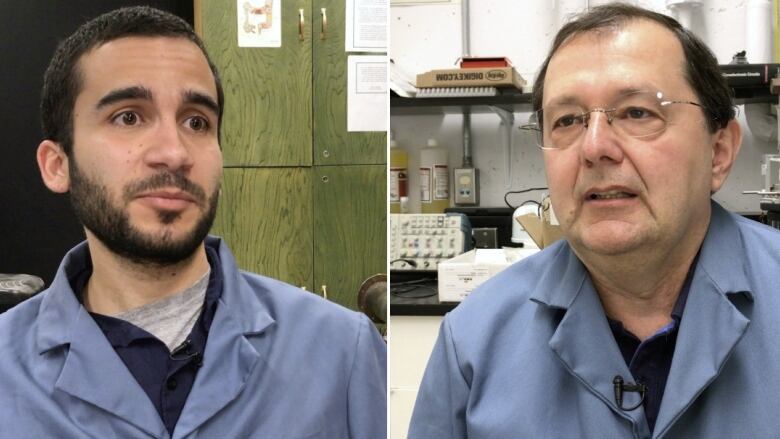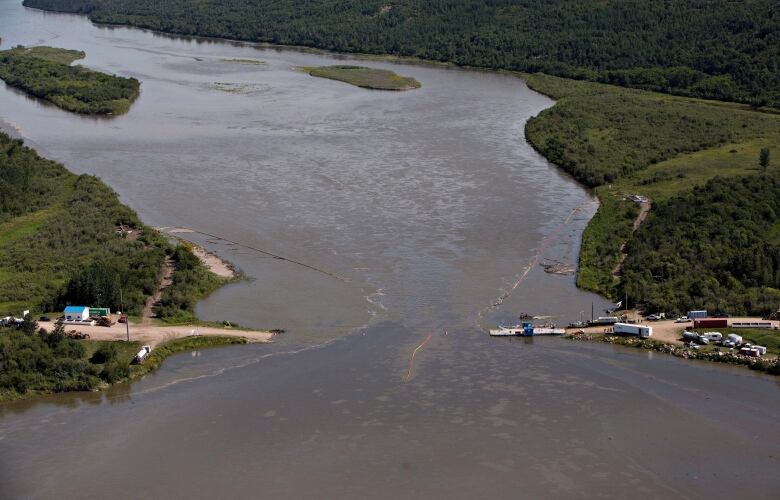Leakproof pipeline design created by University of Calgary researchers
Safer design with zero cleanup costs would benefit the industry and environment, researchers say

In a basement laboratory at the Universityof Calgary, a pair of researchers say they have a solution to one of the key problems facing the oil and gas pipeline industry spills.
The researchers say their system, which combines real-time monitoring and an outer layer around a pipeline, wouldbetter protect the environment and save the reputation of the industry by eliminating leaks though it would come at a higher cost.
"We have a fully functional prototype that illustrates completely the feasibility of the technology," said Martin Mintchev, an engineering professor at the University of Calgary.
Their designsurroundsa pipeline with a larger pipe, made of steel or plastic. A spacebetween the pipeline and the outer layercontains any leaks, andthat's alsowhere a wireless monitoring system canimmediately detectany spills, pinpoint the location and gauge the severity.
- Protests, court challenges: Trans Mountain IPO comes at awkward time for Kinder Morgan
- Indigenous leaders sign opposition to Keystone XL in Calgary
The challenge now, said Mintchev, is "the will of the industry to innovate and invest in environmental protection issues."
Small leak, big problem
For decadesthe pipeline industry operated in near obscurity, butin recent yearsthe sector is at the forefront of political, environmentaland economic debates in Canada. Pipeline spills are highly publicized, and those leaks are one reason whyproposals for future projects are contentious.
"We want our society to be calmer on this issue, because we have a technological solution for leakage problems from pipelines," said Mintchev. We know how to implement it. It is not that expensive compared to the damage eventual leaks can do."

Spills, like Enbridge'snotorious 2010 pipelinerupture thatpoured 3.3 million litres of oil into Michigan's Kalamazoo River and cost more than $1 billion to clean up, happen infrequently considering how much oil and gas pipelines transport across the continent every day.
Regardless, leaks have begun to erode public confidence in pipelinesafety. A poll last year found40 per centof Canadians supported a moratorium on new oil and gas pipelines.
Pipeline companies use advanced technology to monitor their infrastructure and keep a close eye for any leaks. For instance, Calgary-based TransCanadaspent more than $1.5 billion on preventive maintenance programs in 2015, which included more than 700 digs to check pipeline integrity. Drones, pressure sensorsand even specially traineddogs are used by industry to inspect pipelines, whileother techniques are being developed.

"It is not enough," saidThiago Valentin de Oliveira, anelectrical and computer-engineeringmaster's student working on the project. "There is a major reason why all of those monitoring systems that have been proposed in literature, they only detect leakage after it has happened. Our technology not only detects a leak, but also prevents it from happening. That is more important than anything."
The price to protect
Ideally, the researchers would like pipeline companies to use their technology on existing pipelines in sensitive areas, such as near rivers and lakes. They estimate their pipeline design could cost at least 25 per cent more to build, but that could be reduced if the outer protective layer was made of composite material or plastic, instead of steel.
- ANALYSIS: The case for more oil pipelines in Canada
- Can oil and gas wealth improve First Nations conditions?
"Compared to the cost of a leak and to the public relations damage that this leak causes combined with further difficulties developing further pipelines, we find the cost very easily bearable," said Mintchev.
If companies are not interested in licensing their leakproofpipeline system, the researchers plan to launch their own startup toproduce, deliver and install their equipment.
Pipelines transport various materials across Canada, includingcrude oil, bitumen, natural gas, gasoline and jet fuel. The researchers plan further tests of their technology that considersvarious materials and different temperatures.
Valentin de Oliveiraand Mintchev have a patent pendingand will be presenting their leakless pipeline system at the Global Petroleum Show in Calgary next month.














_(720p).jpg)


 OFFICIAL HD MUSIC VIDEO.jpg)
.jpg)



























































































